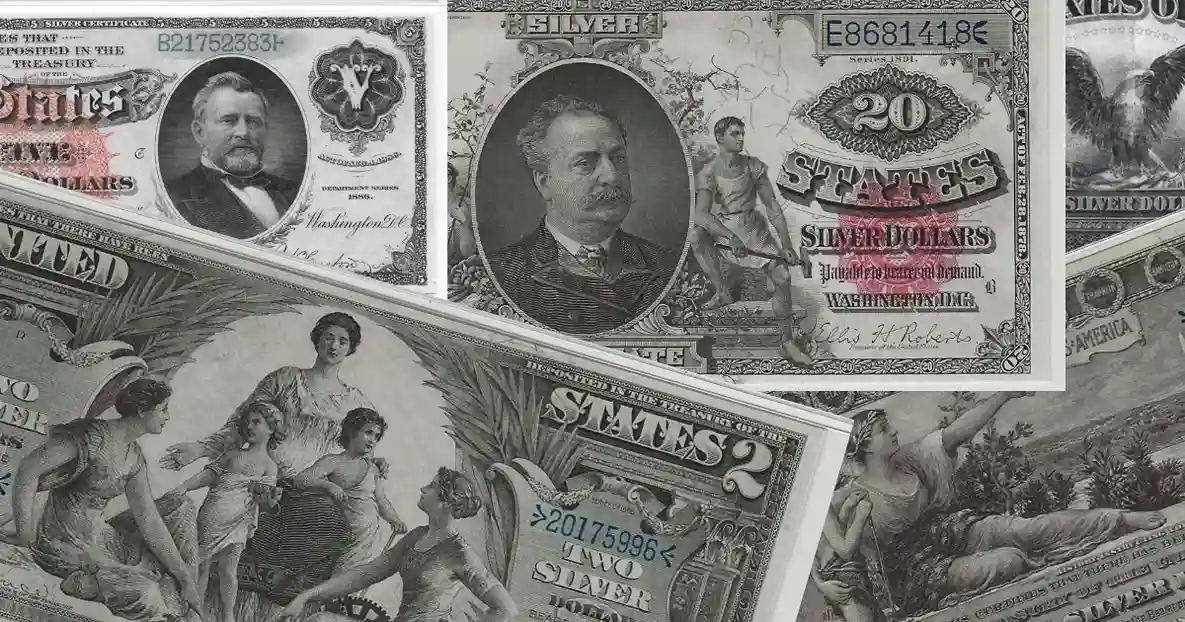Silver certificates are an important piece of American history, and for collectors, they represent more than just monetary value. They are a window into the past. Collecting silver certificates is thrilling, especially when it involves rare notes with exciting histories. Silver certificates are essential to American currency and hold significant historical value today. Their unique features, historical significance, and rarity make them highly valuable among collectors worldwide.
What Are Silver Certificates?
Silver certificates were issued in 1878 as part of the U.S. government’s effort to replace silver coinage. They were once redeemable for their face value in silver coins or bullion, making them a genuinely representative currency.
Today, they no longer hold the redeemable value in silver but have become highly sought after by collectors for their historical significance and unique designs.
These certificates come in various denominations, from the standard $1 notes to higher-value notes such as $10, $50, and even $1,000 certificates. Collectors focus on factors like rarity, condition, and serial numbers when determining the value of a silver certificate.
- The 1896 $1 Silver Certificate – “Educational Series”
The 1896 $1 Silver Certificate is considered one of the most beautiful U.S. notes ever issued. Part of the famed “Educational Series,” this certificate features an intricate design representing “History Instructing Youth.” The front depicts Lady Liberty guiding young America with George and Martha Washington in the background, symbolizing knowledge and progress.
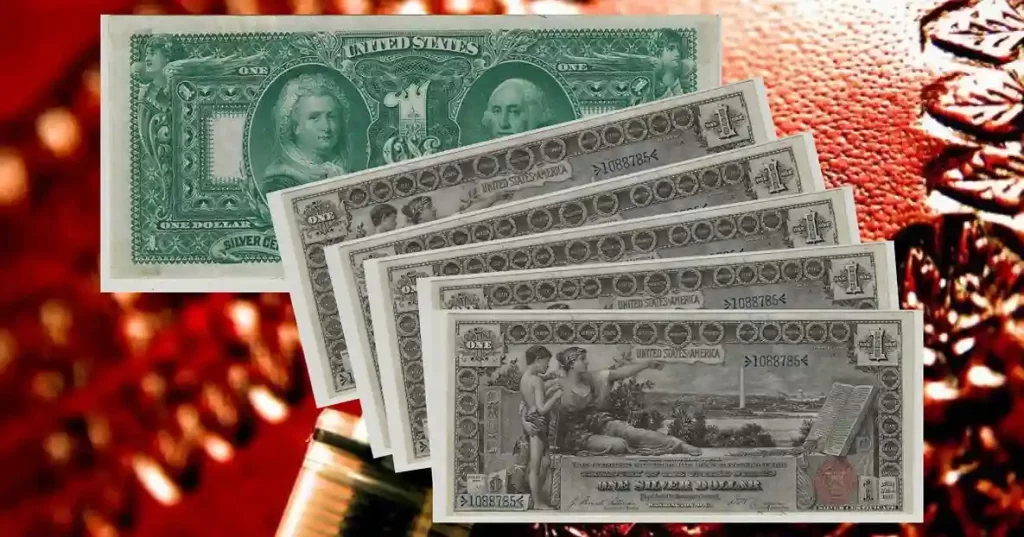
Why It’s Valuable:
This series was produced only for a limited time, making it incredibly rare. Collectors highly prize the Educational Series for its artistic detail and historical symbolism.
Average Value:
A well-preserved 1896 $1 Silver Certificate, depending on its condition, can fetch between $1000 and $5,000. Exceptional specimens in uncirculated condition have even surpassed $10,000 at auction.
Fascinating History:
These certificates represented a shift towards more artistic U.S. currency designs, moving from simple monetary functions to national art pieces.
This note’s rarity, artistry, and historical importance make it one of the most valuable silver certificates on the market.
- The 1886 $5 Silver Certificate – Featuring Ulysses S. Grant
Another high-value silver certificate is the 1886 $5 note featuring Ulysses S. Grant on the front. This certificate stands out due to its distinct design and the historical figure it portrays, reflecting the patriotic pride of the time.
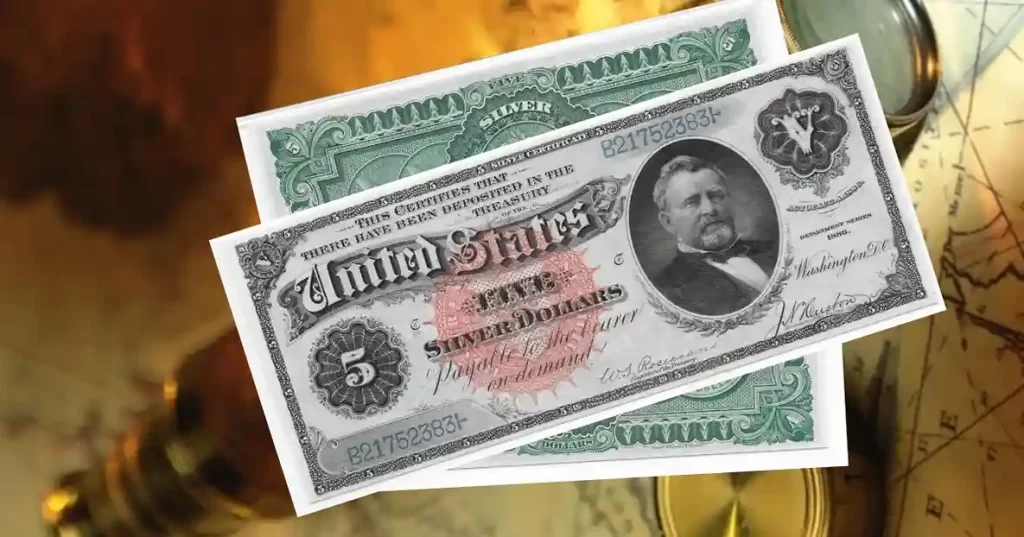
Why It’s Valuable:
The 1886 $5 Silver Certificate is highly prized due to its age, rarity, and the popular image of Grant, a notable historical figure and U.S. president.
Average Value:
Depending on the condition, these notes generally range from $10,000 to $50,000, with pristine, uncirculated notes fetching even more at significant auctions.
Fascinating History:
Issued when U.S. citizens could exchange these notes for silver, this note offers a glimpse into America’s historical monetary policy. Many were redeemed and destroyed, which adds to their rarity today.
Collectors appreciate this silver certificate for its patriotic design and connection to one of America’s most respected presidents.
- 1896 Series $2 Silver Certificate
For collectors and enthusiasts of numismatics, the 1896 Series $2 Silver Certificate is a remarkable example of American currency that combines artistic beauty with historical significance. This note is often celebrated for its intricate design and the rich narrative it embodies from a transformative era in U.S. financial history.
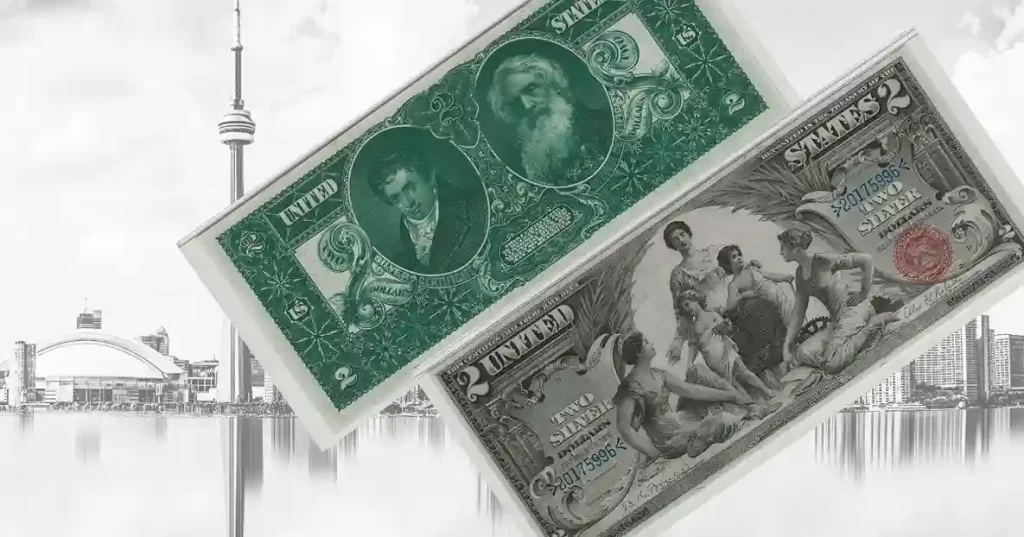
Why It’s Valuable:
The 1896 $2 Silver Certificate is desirable due to its rarity and unique artwork. Known as the “Educational Series,” this certificate features allegorical representations of history, industry, and commerce. Its intricate designs and use of vibrant colors set it apart from other currency issues of the time. The limited availability of this note in high-grade condition increases its appeal among collectors, making it a prized possession in any collection.
Average Value:
In circulated condition, the 1896 $2 Silver Certificate typically holds a value ranging from $1000 to $20,000, depending on its specific condition and market demand. However, uncirculated examples can command significantly higher prices, often exceeding $20,000 and reaching several thousand dollars for specimens in pristine condition.
Fascinating History:
This silver certificate was issued when the U.S. government wanted public confidence in paper currency by backing it with precious metals, specifically silver. The design of the 1896 $2 Silver Certificate features an image of a female allegorical figure representing “History,” who is crowded around with kids, symbolizing youth and the importance of history in shaping the future. This artistic representation, along with the elaborate framing and vivid colors, makes the note a form of currency and a work of art.
The 1896 $2 Silver Certificate also reflects the broader economic context of the time, including the debate over the gold standard versus silver backing. It is a testament to the era’s financial policies and the struggles faced in the American economy, making it an essential piece of monetary history.
Owning an 1896 Series $2 Silver Certificate is more than just possessing a collectible note; it represents a link to a significant chapter in American financial history. Its beautiful design and historical context make it a must-have for novice collectors and seasoned numismatists alike.
- The 1899 $1 Silver Certificate – “Black Eagle” Note
The 1899 $1 Silver Certificate, famous as the “Black Eagle” note, is a distinctive and highly collectible piece. The design features a striking black eagle in flight, symbolizing freedom and power, with portraits of Lincoln and Grant beneath it.
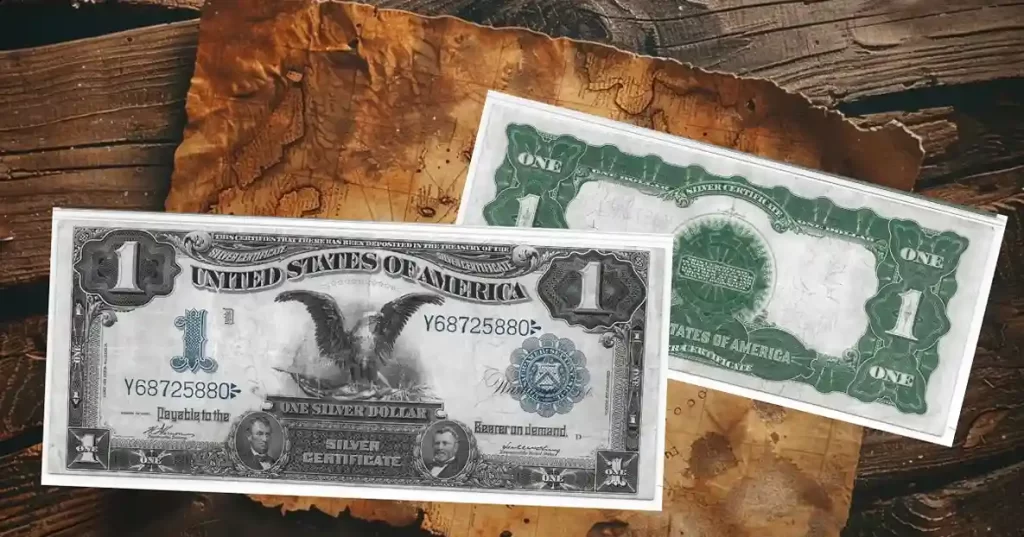
Why It’s Valuable:
The Black Eagle note is valued for its iconic imagery and historical relevance. The combination of Lincoln and Grant’s portraits makes it a collector’s favorite.
Average Value:
These notes are valued between $500 and $2000, depending on the condition. Exceptional, uncirculated notes can reach $3,000 or more.
Fascinating History:
As one of the last U.S. notes to feature an eagle prominently, the Black Eagle note is both a collector’s gem and a patriotic emblem. Its design captures the essence of American strength and history.
This note is among the most affordable rare silver certificates, making it a popular choice for those building a meaningful collection on a budget.
- 1891 Series $20 Silver Certificate
For currency enthusiasts and collectors, the 1891 Series $20 Silver Certificate represents a captivating blend of artistry, history, and monetary significance. Featuring the portraits of Daniel Manning, this certificate stands as a unique piece of American financial heritage. This example was formerly from the collection of Dr. Edward and Joanne Dauer.
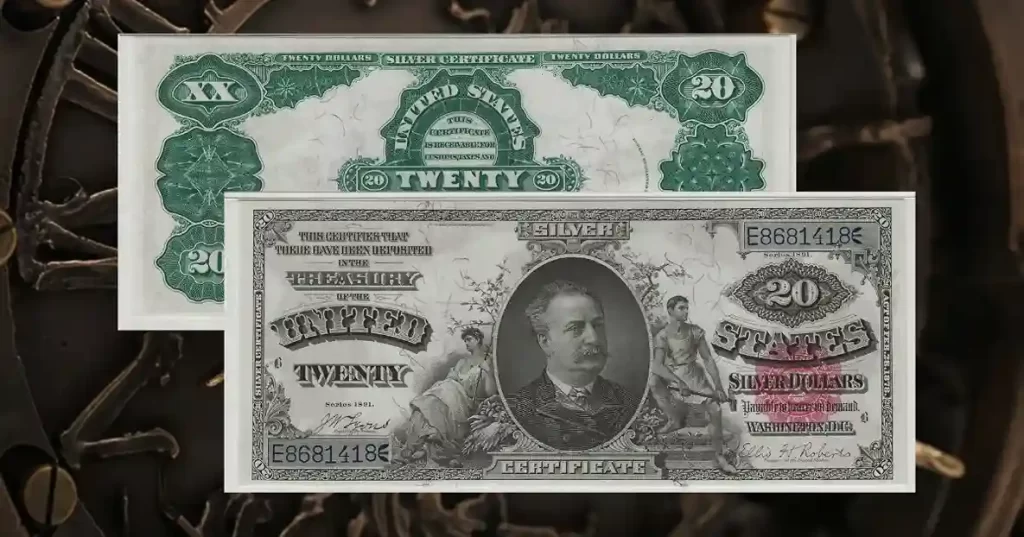
Why It’s Valuable:
The 1891 $20 Silver Certificate is particularly valuable due to its rarity and historical context. With only a limited number of these notes surviving, they are highly sought after by collectors. This series marks a transitional period in U.S. currency, where silver was still used as a backing for paper money. The involvement of prominent figures like Dr. Edward and Joanne Dauer adds a layer of intrigue and collectability, elevating its market value.
Average Value:
The 1891 $20 Silver Certificate can be valued at several hundred dollars in circulated condition. However, well-preserved or uncirculated examples can command prices ranging from $5,000 to $50,000 or even more, depending on the note’s condition, rarity, and the current demand among collectors.
Fascinating History:
The 1891 Series is notable for depicting Daniel Manning, an influential figure in the era’s banking and finance sectors. This note represents a specific moment in U.S. history and reflects the broader economic conditions of the time, including using silver as a monetary standard. As many of these certificates were issued during significant financial change, they are emblematic of the era’s complex relationship with currency and banking.
Holding an 1891 Series $20 Silver Certificate is akin to possessing a piece of American history. Its unique design, coupled with the notable figures it features, makes it a highly desirable item for both novice and seasoned collectors. This certificate is not merely a form of currency but a tangible connection to the past, embodying the stories and struggles of a critical period in American financial history.
Why It’s Important to Choose the Right Silver Certificates Dealer:
The growing demand for collectible silver certificates has increased the number of dealers in the market. However, not all dealers are certified and provide authentic currency. Choose a reputable dealer to protect yourself from fraud, overpricing, or counterfeit items.
Authenticity:
Does the dealer guarantee authenticity for the silver certificates they sell? Look for dealers who offer third-party grading services from reputable organizations like PMG (Paper Money Guaranty) or PCGS (Professional Coin Grading Service).
Experience and Expertise:
Choose dealers with years of experience in the field. Experienced dealers will likely offer accurate information about your certificates and fair pricing.
Customer Reviews:
Customer feedback can give you insights into a dealer’s reliability and trustworthiness. Look for consistently positive reviews, especially those that praise honesty, customer service, and product quality.
Return Policy:
A good dealer will offer a fair return policy if you’re unsatisfied with your purchase. Ensure you check the terms and conditions before finalizing any deals.
Shipping and Packaging:
Proper shipping methods and secure packaging are essential when dealing with valuable items like silver certificates. Make sure your dealer prioritizes safe delivery.
Understanding Dealer Ratings and Reviews:
When shopping for silver certificates, ratings and reviews are crucial. These reflect real customer experiences and can provide insight into a dealer’s trustworthiness.
5-Star Reviews:
Look for consistency in 5-star reviews. A top-rated dealer like Sanchez Currency often boasts numerous 5-star reviews, praising the authenticity of their products, customer service, and transparency.
Negative Reviews:
No dealer is perfect, but it’s essential to consider how a dealer responds to negative reviews. Did they address the complaint professionally and promptly? This can be a sign of a company that cares about customer satisfaction.
Third-Party Ratings:
Many reputable dealers, including Sanchez Currency, submit their products to third-party grading services like PMG and PCGS. High ratings from these organizations are a solid indicator of a dealer’s reliability.
Why Sanchez Currency is the #1 Choice Of Collectors:
Finding the right dealer is essential if you’re looking to buy or sell silver certificates or any other paper currency. Sanchez Currency stands out as the top-rated dealer in 2024 for its exceptional customer service, guarantee of authenticity, transparent pricing, and educational resources. Whether you’re a seasoned collector or just starting, Sanchez Currency provides a seamless and secure way to add valuable paper currency to your collection.
With a strong reputation, stellar reviews, and a commitment to customer satisfaction, Sanchez Currency is rated #1 in the market.

